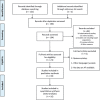N-3 polyunsaturated fatty acids to prevent atrial fibrillation: updated systematic review and meta-analysis of randomized controlled trials
- PMID: 23525440
- PMCID: PMC3603239
- DOI: 10.1161/JAHA.112.005033
N-3 polyunsaturated fatty acids to prevent atrial fibrillation: updated systematic review and meta-analysis of randomized controlled trials
Abstract
Background: Previous studies have suggested that n-3 polyunsaturated fatty acids (n-3 PUFAs) have antiarrhythmic effects on atrial fibrillation (AF). We aimed to assess the effects of therapy with n-3 PUFAs on the incidence of recurrent AF and on postoperative AF.
Methods and results: Electronic searches were conducted in Web of Science, Medline, Biological Abstracts, Journal Citation Reports, and the Cochrane Central Register of Controlled Trials databases. In addition, data from the recently completed FORωARD and OPERA trials were included. We included randomized controlled trials comparing treatment with n-3 PUFAs versus control to (1) prevent recurrent AF in patients who underwent reversion of AF or (2) prevent incident postoperative AF after cardiac surgery. Of identified studies, 12.9% (16 of 124) were included, providing data on 4677 patients. Eight studies (1990 patients) evaluated n-3 PUFA effects on AF recurrence among patients with reverted AF and 8 trials (2687 patients) on postoperative AF. Pooled risk ratios through random-effects models showed no significant effects on AF recurrence (RR, 0.95; 95% CI, 0.79 to 1.13; I(2), 72%) or on postoperative AF (0.86; 95% CI, 0.71 to 1.04; I(2), 53.1%). A funnel plot suggested publication bias among postoperative trials but not among persistent AF trials. Meta-regression analysis did not find any relationship between doses and effects (P=0.887 and 0.833 for recurrent and postoperative AF, respectively).
Conclusions: Published clinical trials do not support n-3 PUFAs as agents aimed at preventing either postoperative or recurrent AF.
Clinical trial registration: URL: http://www.crd.york.ac.uk/PROSPERO. Unique Identifier: CRD42012002199.
Figures







References
-
- Heeringa J, van der Kuip DA, Hofman A, Kors JA, van Herpen G, Stricker BH, Stijnen T, Lip GY, Witteman JC. Prevalence, incidence and lifetime risk of atrial fibrillation: the Rotterdam study. Eur Heart J. 2006; 27:949-953 - PubMed
-
- Lafuente‐Lafuente C, Mouly S, Longas‐Tejero MA, Bergmann JF. Antiarrhythmics for maintaining sinus rhythm after cardioversion of atrial fibrillation. Cochrane Database Syst Rev. 2007:CD005049. - PubMed
-
- Connolly SJ, Camm AJ, Halperin JL, Joyner C, Alings M, Amerena J, Atar D, Avezum Á, Blomström P, Borggrefe M, Budaj A, Chen SA, Ching CK, Commerford P, Dans A, Davy JM, Delacrétaz E, Di Pasquale G, Diaz R, Dorian P, Flaker G, Golitsyn S, Gonzalez‐Hermosillo A, Granger CB, Heidbüchel H, Kautzner J, Kim JS, Lanas F, Lewis BS, Merino JL, Morillo C, Murin J, Narasimhan C, Paolasso E, Parkhomenko A, Peters NS, Sim KH, Stiles MK, Tanomsup S, Toivonen L, Tomcsányi J, Torp‐Pedersen C, Tse HF, Vardas P, Vinereanu D, Xavier D, Zhu J, Zhu JR, Baret‐Cormel L, Weinling E, Staiger C, Yusuf S, Chrolavicius S, Afzal R, Hohnloser SHPALLAS Investigators Dronedarone in high‐risk permanent atrial fibrillation. N Engl J Med. 2011; 365:2268-2276 - PubMed
-
- Vassallo P, Trohman RG. Prescribing amiodarone: an evidence‐based review of clinical indications. JAMA. 2007; 298:1312-1322 - PubMed
Publication types
MeSH terms
Substances
LinkOut - more resources
Full Text Sources
Other Literature Sources
Medical

